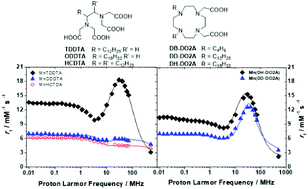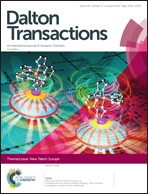Abstract
In the research field of MRI contrast agents (CAs), amphiphilic paramagnetic complexes are typically sought for the increased plasmatic half-life and high relaxivity values, but limited examples of amphiphilic Mn2+-based CAs have been reported to date. In this work the Mn2+-complexes of six original amphiphilic ligands (three EDTA-like ligands and three 1,4-DO2A derivatives) embodying one or two aliphatic chains were evaluated as potential MRI contrast agents and compared. Strong self-association into micelles resulted in a relaxivity (r1) enhancement (ca. 80% with respect to MnEDTA) as a consequence of the increased molecular tumbling rate of the supramolecular aggregate. In the case of bis-substituted systems the r1 gain is much higher due to the restricted local rotation of the chelates about the pendant aliphatic chains (r1 in the range 12.6–18.4 mM−1 s−1, 2–3 times higher than for the micelles obtained with single-chain EDTA systems). Furthermore, these amphiphilic chelates tightly bind to human serum albumin (HSA) with association constants KA in the range 104–105 M−1. The resulting supramolecular adducts achieve remarkable relaxivity values, in the range 50–60 mM−1 s−1 for the MnEDTA-like chelates and 27–30 mM−1 s−1 for the 1,4-DO2A-like systems (at 298 K and 20 MHz), thanks to their fast water exchange rate.

- This article is part of the themed collection: New Talent: Europe


 Please wait while we load your content...
Please wait while we load your content...